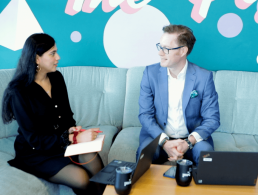PwC’s David Keane and Aisling Corcoran examine the steps employers need to take for their employees’ wellbeing and how the HR role is changing.
Consistent with what we are seeing from our research in Ireland, a recent PwC US survey found that 72pc of employees prefer a hybrid working environment, with 55pc saying they would like to work remotely three or more days per week. With the availability of key talent a challenge for many businesses, the survey further confirms that flexible working contributes to retention.
The transition to remote working as a result of the pandemic has upended our traditional views of the workplace and the purpose it serves. Lots of organisations have shifted from their conventional view of the workplace as near-enough to 100pc on-site. Some are even considering 100pc remote. But many are looking at a variation of a hybrid model, which lies anywhere in between.
This forced reimagination of how and where we work has provided a unique opportunity to redefine the role of the workplace in providing real added value for organisations, teams and their people.
A hybrid model may consist of several different characteristics from both spectrums that will work uniquely for a particular organisation and its workforce. To practically apply the notion of a hybrid model, organisations must consider what they want the purpose of their primary office space to be.
Depending on the hybrid model chosen, this can mean different things. For example, will the office become solely a place for employees and client events? Will the office be redesigned as a training hub? Or should the office be leveraged as an innovation and creativity hub for teams and individuals to come together to brainstorm new ideas.
Some organisations might also consider the notion of ‘hub and spoke’ (a combination of both central and regional workspaces) where remote working can still take precedence with a main office ‘hub’ for dedicated activities and additional ‘spoke’ offices across regions. This can further accommodate flexibility and expand talent pools that include regional, rural and international talent.
The evolution of employee wellbeing
Employee wellbeing has moved on beyond just supporting physical wellness. Especially since the start of the pandemic, we have seen a greater focus on supporting employees holistically – emotionally, financially and socially (including relationship building and human relations skills) as well as physically. This also includes considering the environment in which employees work, whether this be at home, in the office or at other workplace sites.
Many organisations are now evaluating their position and reimaging what their wellbeing strategy needs to look like long-term. There are many challenges when it comes to implementing a successful wellbeing strategy. Employees are increasingly dispersed and physically disconnected. The borders between home and work life are more blurred than ever. And the physical, mental and emotional impacts of long-term working from home are becoming evident.
A robust wellbeing strategy, however, can ensure a resilient, happy and healthy workforce which in turn leads to increased productivity and cost reductions linked to lower absenteeism and attrition. In addition, the enhanced company reputation which results can help attract and retain the best talent.
As organisations look to the future with a view to designing and implementing a relevant wellbeing strategy, it is crucial to remember that there can be no ‘one size fits all’ approach. Our top tips to assist in designing the right wellbeing strategy for your organisation are:
- Use a data-led approach to identify employee and business-specific needs
- Identify what is working and what can be improved
- Use data to undertake modelling to plot where you are now versus where you want to be and to create a business case for change
- Engage wider stakeholders to agree your objectives and use a data-driven methodology to develop your strategy
- Continually measure return on investment using data-driven metrics
How the role of HR and people managers have changed
This new world of work is also changing the leadership dynamic including the role of HR and people managers. They are having to lead in a world unlike anything we have experienced before. Leaders will need to work hard to communicate expectations clearly. This needs to be part of a wider shift in corporate culture, one that really encourages flexibility and puts employee wellbeing first.
HR leaders and people managers will need to adapt their practices, policies and engagement models to facilitate the various cohorts of employees working remotely or in the office on a given day.
A key aspect will be to ensure that all employees no matter where, when or how they are working are equally included and have the same opportunities to collaborate, innovate and problem-solve together. Leaders will also need to ensure that they are compliant with Government advice on remote working, health and safety and any guidance or legislation on a return to the workplace.
There is no correct answer, but an agile approach will be critical to success. Leaders will need to recognise and accept this and implement regular reflection points where you review your approach based on feedback from employees.
4 actions to help define the purpose of your future office
Remember: Leverage the learnings from the ways of working throughout the pandemic. A thorough reflection on remote working can help you understand what elements of remote working you want to retain in your new workplace model and which you wish to leave behind.
Rebuild: Take stock and take action. Remodelling the workplace for your organisation requires consideration of the business strategy, the people and culture, compliance and risk, and technology and learning, in addition to the physical environment. Your workplace will also increasingly become a key factor in attraction and retention of key talent. Implementing an agile, flexible approach will enable your organisation to stretch and scale as lessons are learnt and priorities change.
Redefine: Reimagine your workplace with collaboration at the centre and in a way that supports different types of work preferences. Strategically marry physical and non-physical elements to make your workplace one where employees actively want to be and not have to be.
Reimagine: Organisations have to future-proof their offices, from ensuring adequate spacing and mitigating bottlenecks to reviewing air conditioning and implementing zero-touch technologies. Identify what is a permanent fixture of your new normal and undertake scenario planning, so you are equipped with contingency plans and responses to future disruption.
By David Keane and Aisling Corcoran
David Keane is a director and Aisling Corcoran is a manager, both working in PwC’s people and organisation consulting department.




